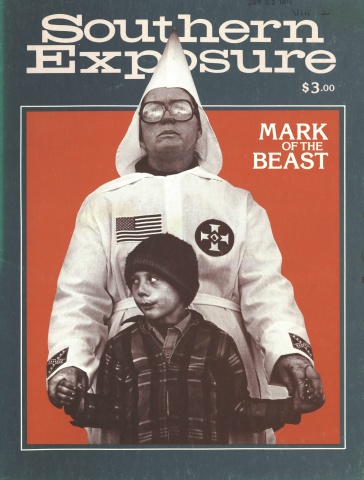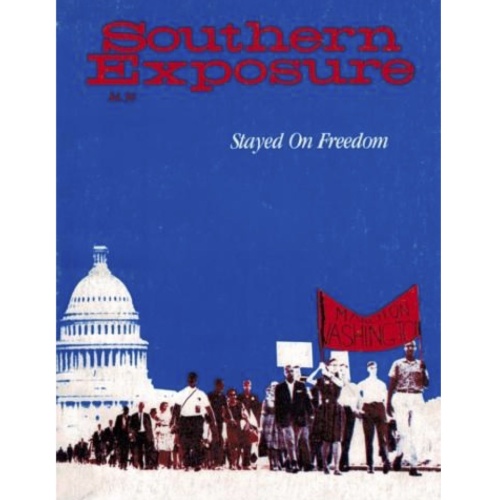111 Years of KKKronology

This article originally appeared in Southern Exposure Vol. 8 No. 2, "Mark of the Beast." Find more from that issue here.
The following article contains anti-Black racial slurs.
Spring, 1866: Confederate veterans formed the Klan in Pulaski, Tennessee.
1867: With General Nathan Bedford Forrest as Grand Wizard, the organizational structure of the KKK developed to accomodate its spread across the South. Invasion of black homes, flogging of blacks and whites became commonplace.
July 4, 1867: Klansmen, most of whom were ex-Confederates, marched in major Southern cities in full regalia.
1871: 297 blacks lynched in one month in New Orleans.
1871-1872: Congressional investigations led to a few hundred Klansmen being brought to trial for violence. Congress passed the Ku Klux Klan Act that made it a crime for anyone to deprive citizens of their constitutional rights.
1874: 200 blacks killed in one week before elections in Vicksburg, Mississippi.
1866-1875: 3,500 blacks killed in the South by the Klan.
1877: President Rutherford B. Hayes pulled federal troops out of the South in a trade-off for crucial Southern support in his bid for the Presidency.
1877: Southern states began to pass “black codes” eroding the newly won freedom of the black slaves.
1896-1900: Ku Klux Klan and Red Shirts (another paramilitary organization) conducted campaigns of terror to break up white-black political coalitions.
1896: The U.S. Supreme Court upheld segregation and Jim Crow laws in the case of Plessy vs. Ferguson, saying “separate but equal” facilities were constitutional.
1900-1914: The KKK lynched 1,100 blacks.
1909: The National Association for the Advancement of Colored People (NAACP) organized to combat Jim Crow laws and anti-black violence.
1915: The Birth of a Nation, Hollywood’s first full-length motion picture, glorified the role of the Ku Klux Klan in saving the South from “carpetbaggers and niggers.” President Wilson was given a private showing of Birth of a Nation and remarked “It is like writing history with lightning.” One of the most controversial and racist film sever marketed, it generated an enormous furor because of its anti-black stereotypes.
1915: On Thanksgiving Eve, William Joseph Simmons invited 15 friends to the top of Stone Mountain, near Atlanta, built an altar, and set fire to a wooden cross. This ceremony launched the Invisible Empire of the Ku Klux Klan, which became the largest KKK organization in the history of the United States.
1918-1921: Twenty-eight blacks burned alive. Some of these had just returned from World War I and were murdered in their military uniforms. 1920: The Invisible Knights of the KKK grew to an estimated three-and- a-half million members and directed their wrath toward blacks, immigrants. Catholics, Jews and “nigger lovers.”
December, 1921: 6,000 people attended a public rally of the Ku Klux Klan in Portland, Oregon.
1920-1930: Klan-supported candidates won top political offices throughout the nation. July 4,
1923: David C. Stephenson was sworn in as Indiana’s Grand Dragon before a crowd of 100,000 Klansmen.
August 8, 1925: 40,000 Klansmen marched through the streets of Washington, DC, past the Washington Monument, one of the largest demonstrations of its kind in the nation’s capitol.
1930: The Ku Klux Klan was on the road to collapse from internal pressures, and a broadening of opposition from anti-Klan groups.
1944: The Internal Revenue Service filed suit against the Invisible Empire for $685,000 in back taxes.
1947: Stetson Kennedy exposed the Klan in his book I Rode With the Ku Klux Klan.
1948: President Franklin Roosevelt was pressured by blacks into issuing an executive order banning racial discrimination in the armed forces and war-related industries.
1954: The U.S. Supreme Court’s Brown vs. the Board of Education held that segregated schools were in violation of the Constitution.
December, 1955: Alabama woman named Rosa Parks, supported by the Montgomery Improvement Association, sparked a protest movement that spread across the South when she refused to give up her seat on a city bus in Montgomery, Alabama.
October, 1957: Blacks in Monroe, North Carolina, opened fire on Ku Klux Klan night riders, a strategy that would be followed by Native Americans in Robeson County, North Carolina, months later.
1954-1965: U.S. Justice Department figures show that the Klan was responsible for 70 bombings in Georgia and Mississippi, 30 black church bombings in Mississippi, the castration of a black man in Alabama, and 50 bombings in Birmingham.
1961: Freedom rides began to force desegregation of public facilities in the South.
1963: The Sixteenth Street Baptist Church was bombed in Birmingham and four young black girls killed in their Sunday School class.
1964: The Mississippi Freedom Summer project brought scores of white students from the North to work with the Council of Federated Organizations. The whites became the target of KKK terror which had frustrated COFO’s progress.
1964: Michael Schwerner, Andrew Goodman and James Chaney, young civil-rights workers, were killed by the Original Knights of the Ku Klux Klan near Philadelphia, Mississippi.
1965: Viola Liuzzo, a Detroit housewife, was killed by four Klansmen (including FBI informer Gary Thomas Rowe, Jr.), following the historic march from Selma, Alabama, to Montgomery, Alabama. The march brought pressure on Congress to pass the Voting Rights Act of 1965, which brought federal protections in elections across the South.
1965: Deacons for Defense and Justice organized to patrol the black community in Jonesboro, Louisiana, and to defend the community against Klan night riders.
1966-1969: The House Un-American Activities Committee held hearings on the KKK. Several leaders were sentenced to jail for contempt of Congress for refusing to turn over records of finances and membership. The Klan went underground.
1969: A Charlotte federal district court ordered the Charlotte School Board to bus school students to achieve racial balance in schools. Klan-led violence began but then subsided, a pattern duplicated across the South.
Mid-1970s: Klan membership increased in the North following integration of schools through crosstown busing. The most violent attacks on black students occurred in Boston and Detroit suburbs.
1977: 250 Klansmen rallied in President Jimmy Carter’s hometown of Plains, Georgia. The event ended when a speeding car crashed into the speaker’s platform.
Sources: John L. Stewart, KKK Menace: The Cross Against the People, 1980; Robert P. Ingalls, Hoods, The Story of the Ku Klux Klan, Putnam, 1979; Ted Quant and John Slaughter, We Won’t Go Back: The Rise of the Ku Klux Klan and the Southern Struggle for Equality, Equal Rights Congress, 1980.
Tags
Southern Exposure
Southern Exposure is a journal that was produced by the Institute for Southern Studies, publisher of Facing South, from 1973 until 2011. It covered a broad range of political and cultural issues in the region, with a special emphasis on investigative journalism and oral history.
